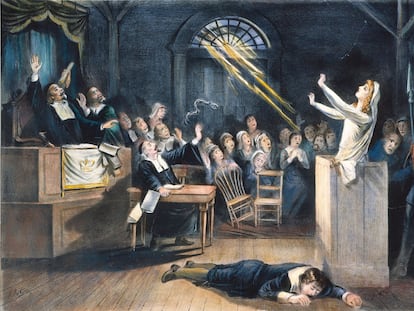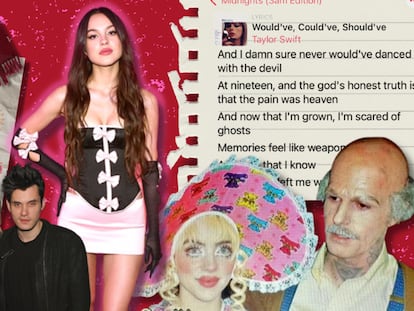Why do we still use the image of witches created by the inquisitors?
Several international initiatives are trying to break the stereotype of a devilish, cackling, long-nosed hag, and restitute the memory of the victims of the largest femicide in history

Today, everybody knows that the women victims of the witch hunts were not Satan-worshipping sorceresses. The term “witch hunt” itself now refers to the persecution of innocents. Nonetheless, to this day witches are portrayed as ugly old women with big noses, warts, smelly breath and devilish smiles who keep black cats as companions and ride brooms. Some even have green skin. This description is similar to the one that the inquisitors and witch hunters used to spread; the way in which those who feared them imagined them. The tale of the victors.
“The witch hunt is the biggest femicide in history, but it is not studied in schools or universities. It has not only been forgotten; it has become a legend. The witch is a fairy tale character, practically a joke,” explained the Italian-American thinker Silvia Federici, author of Caliban and the Witch, at the Second International Feminist Encounter on the Witch-hunt, held last October in Madrid.
A quick search in an online image bank like Getty Images is enough to see how the stereotype has become generalized. Thousands of files show the witch represented in the usual way; in old engravings, at Halloween parties, lost in misty forests, in school games. Sometimes it is a playful girl disguised as a little witch, other times it is a woman in an erotic pose. Sometimes the image is trying to instill fear and other times it is but a harmless caricature. But it is always the witch with the broom and the pointy hat. This is how the victims of a massacre are remembered.
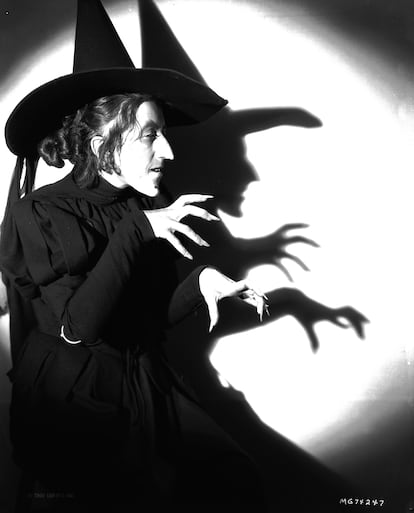
A persistent stereotype
“It is necessary to reliably recover the memory of those women who were murdered, imprisoned, exiled or tortured,” explains Beatriz García, one of the promoters of the Campaign for the memory of women persecuted for witchcraft, which has reading and research groups in various cities in Spain as well as Quito (Ecuador) and New York. In Spain they have visited various places where the persecution of women took place, like the municipality of Laspaules in the autonomous community of Aragon, where 24 women accused of witchcraft were tortured and hanged in 1593 and where today a theme park tells their story (aided by the usual iconography of a witch with a peaked hat). Or that of Miraflores de la Sierra, in the Community of Madrid, where in the mid-17th century two poor widows were blamed for a series of inexplicable deaths of children and sent to the Inquisition prison in Toledo.
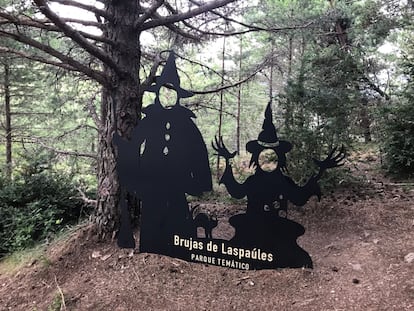
“We found that in many places where there was a witch hunt, nobody remembers,” says García, “and what is surprising is that in those places where they do, and even where historical events are explained exactly as they happened, the classic image of the witch is still used in iconography, souvenirs or popular festivals.” The figure of the sorceress was born long before the witch hunt of the modern era; it has been present since mythologies and literatures exist. Some are evil, like Circe, an enchantress that transforms men into beasts in Homer’s Odyssey. Others are benevolent, like the Lady of the Lake who guards the prodigious sword Excalibur in the legend of King Arthur. But the stereotypical image of the evil sorceress as an old woman who eats children and concocts ointments and poisons in the depths of the forest is typical of the witch hunt of the modern period, and the most widespread today.
“Some women who were accused of witchcraft were prominent, but the vast majority was old and poor. Many had knowledge of medicine or herbs and did not have a man to protect them,” explains chemist Adela Muñoz, who approached the world of witches by researching their ointments and poisons and who published the book Brujas: La locura de Europa en la Edad Moderna (Witches: The madness of Europe in the Modern Age). “They were powerful in the minds of the witch hunters, but not in reality.”
The prevalence of the perverse image of the witches – when in reality they were mostly peasants with no connection to midnight covens or dealings with billy goats – is due to various factors. The weight of tradition, its replication in numerous cultural products, from gothic horror stories to movies and musicals, as well as the profitability of the witch stereotype when it comes to selling products, devising fairground attractions or generating tourist interest.
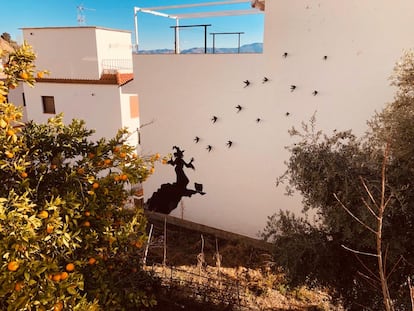
A positive view of witches has also been passed down, even if it is not as widespread as the negative stereotype. “It happens when the witch is stripped of her perverse connotations and she remains as a powerful woman, a symbol of empowerment,” says Muñoz. Between 1968 and 1970, for example, an American collective carried out guerrilla feminism – typical of the radicalism of the time – under the name WITCH (Women’s International Terrorist Conspiracy from Hell). With a dose of humor, the members of WITCH carried out acts of protest and performances wearing all the witch imagery, casting spells in front of the Wall Street stock exchange or holding public covens. Some see them as the precursors of movements like the Guerrilla Girls, Pussy Riot or Femen.
The witch hunt and the birth of capitalism
The reasons for the phenomenon of the witch hunt that occurred at that specific moment in history are varied: collective psychosis, the publication of the Malleus Maleficarum (a widely distributed witch-hunting manual published in 1487), exacerbated misogyny and the dynamics of religious beliefs or the Church itself.
Silvia Federici’s approach focuses on the political and the economic. According to her research, the transition from the feudal system to capitalism required the disciplining of women in order to push them into the reproductive role in the domestic sphere. This discipline was achieved by means of the witch hunt, in the same way that, as Marx observed, capitalism required the plundering of communal lands or slavery in the processes known as the original capital accumulation. “There was a change and a new typology of women: passive, obedient, devoid of rights,” explains Federici. “Until recently, women were not legal entities and had to be represented by a man for any process.” The witch hunt did not remain in Europe or the United States; it went on to all the colonies, brought by missionaries and conquerors.

In that sense, the witch hunt, which we associate with the past, continues in parts of Latin America, Asia or Africa, as stated at the feminist encounter held in Madrid and according to reports from the United Nations, which has a Witchcraft and Human Rights Network. In a July 2021 resolution, the UN urged the governments to take all necessary steps to eliminate the violence related to witchcraft accusations. According to Federici, governments and large companies use these accusations to take advantage of the persistent magical thinking, create discord in communities and break them from within for extractivist purposes. “Their intent is to destroy the community relationship, in order to expel the population and privatize the land. We must not let this story be forgotten,” concludes the thinker. “It is not a story from the past, but from the present.” For this reason, in the opinion of the activists for the restitution of memory, the frivolization of the representation of witches is an even more serious matter today.
Sign up for our weekly newsletter to get more English-language news coverage from EL PAÍS USA Edition
Tu suscripción se está usando en otro dispositivo
¿Quieres añadir otro usuario a tu suscripción?
Si continúas leyendo en este dispositivo, no se podrá leer en el otro.
FlechaTu suscripción se está usando en otro dispositivo y solo puedes acceder a EL PAÍS desde un dispositivo a la vez.
Si quieres compartir tu cuenta, cambia tu suscripción a la modalidad Premium, así podrás añadir otro usuario. Cada uno accederá con su propia cuenta de email, lo que os permitirá personalizar vuestra experiencia en EL PAÍS.
¿Tienes una suscripción de empresa? Accede aquí para contratar más cuentas.
En el caso de no saber quién está usando tu cuenta, te recomendamos cambiar tu contraseña aquí.
Si decides continuar compartiendo tu cuenta, este mensaje se mostrará en tu dispositivo y en el de la otra persona que está usando tu cuenta de forma indefinida, afectando a tu experiencia de lectura. Puedes consultar aquí los términos y condiciones de la suscripción digital.
More information
Archived In
Últimas noticias
Russell Tovey: ‘I was advised many times not to come out, I don’t think there was many people who’d done that — and I feel really proud that I’m one of those that did’
Patagonia’s puma population soars thanks to unexpected prey: penguins
Merz tries to replace Macron at the helm of Europe
Indulgence, punishment and family dynamics: Maintaining a healthy relationship with food during the holiday season
Most viewed
- Christian Louboutin: ‘Young people don’t want to be like their parents. And if their parents wear sneakers, they’re going to look for something else’
- The low-cost creative revolution: How technology is making art accessible to everyone
- US sanctions against jailed cartel leader ‘El Marro’ highlight Mexico’s lack of control over its prisons
- Liset Menéndez de la Prida, neuroscientist: ‘It’s not normal to constantly seek pleasure; it’s important to be bored, to be calm’
- Cartels in Mexico take a leap forward with narco-drones: ‘It is criminal groups that are leading the innovation race’
